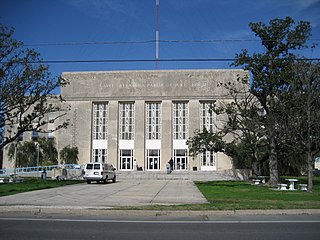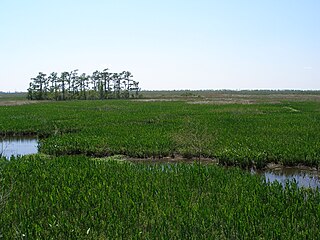
Rodriguez Canal was a ditch that cut across the battlefield during the Battle of New Orleans in 1815. Andrew Jackson arranged his defensive line behind it.

Rodriguez Canal was a ditch that cut across the battlefield during the Battle of New Orleans in 1815. Andrew Jackson arranged his defensive line behind it.
Rodriguez Canal is a disused millrace for a sawmill between the Chalmette and Macarty plantations. The dilapidated canal measured about four feet deep by twenty feet wide at the time of the Battle of New Orleans, and stood as a natural battlefield divide between the combatants. General Jackson arranged his defensive line behind this ditch, building ramparts behind it. Today, the canal ruins form part of the Jean Lafitte National Historical Park and Preserve. [1] [2]

St. Bernard Parish is a parish in the U.S. state of Louisiana. The parish seat and largest community is Chalmette. The parish was formed in 1807. St. Bernard Parish is part of the New Orleans–Metairie metropolitan statistical area; the parish is located southeast of the city of New Orleans and comprises the Chandeleur Islands and Chandeleur Sound in the east.

Arabi is a census-designated place (CDP) in St. Bernard Parish, Louisiana, United States. It lies on the eastern bank of the Mississippi River, between the Lower 9th Ward of New Orleans and Chalmette within the Greater New Orleans metropolitan area. The population was 4,533 at the 2020 census.

Chalmette is a census-designated place (CDP) in, and the parish seat of, St. Bernard Parish in southeastern Louisiana, United States. The 2010 census reported that Chalmette had 16,751 people; 2011 population was listed as 17,119; however, the pre-Katrina population was 32,069 at the 2000 census. At the 2020 U.S. census, its population rebounded to 21,562. Chalmette is part of the New Orleans–Metairie–Kenner metropolitan statistical area. Chalmette is located east of downtown New Orleans and south of Arabi, towards Lake Borgne.

The Battle of New Orleans was fought on January 8, 1815, between the British Army under Major General Sir Edward Pakenham and the United States Army under Brevet Major General Andrew Jackson, roughly 5 miles (8 km) southeast of the French Quarter of New Orleans, in the current suburb of Chalmette, Louisiana.

Major General Sir Edward Michael Pakenham,, was an Anglo-Irish Army officer and politician. He was the son of the Baron Longford and the brother-in-law of the Duke of Wellington, with whom he served in the Peninsular War. During the War of 1812, he was the commander of British forces attempting to take the Southern port of New Orleans (1814–15). On 8 January 1815, Pakenham was killed in action while leading his men at the Battle of New Orleans.

Brian Kilmeade is an American television and radio presenter and political commentator for Fox News. On weekdays he co-hosts the morning show, Fox & Friends, and he hosts the Fox News Radio program The Brian Kilmeade Show. On weekends, he hosts One Nation with Brian Kilmeade, which premiered January 29, 2022. He has authored or co-authored non-fiction and fiction books.

Jean Lafitte National Historical Park and Preserve protects the natural and cultural resources of Louisiana's Mississippi River Delta region. It is named after French pirate Jean Lafitte and consists of six separate sites and a park headquarters.

Bayou Bienvenue is a 12.1-mile-long (19.5 km) bayou and "ghost swamp" in southeastern Louisiana. It runs along the political border between Orleans Parish and St. Bernard Parish to the east of New Orleans. The Bayou Bienvenue Wetlands Triangle viewing platform in the Lower Ninth Ward provides expansive views of the bayou and also serves as an educational resource about restoration efforts in the area.

Manassas National Battlefield Park is a unit of the National Park Service located in Prince William County, Virginia, north of Manassas that preserves the site of two major American Civil War battles: the First Battle of Bull Run, also called the Battle of First Manassas, and the Second Battle of Bull Run or Battle of Second Manassas. It was also where Confederate General Thomas J. Jackson acquired his nickname "Stonewall". The park was established in 1936 and listed on the National Register of Historic Places on October 15, 1966.

Chalmette National Cemetery is a United States National Cemetery located within Jean Lafitte National Historical Park and Preserve in Chalmette, Louisiana. The cemetery is a 17.5-acre (7.1 ha) graveyard adjacent to the site that was once the battleground of the Battle of New Orleans, which took place at the end of the War of 1812. Despite its proximity to the site of the Battle of New Orleans in the War of 1812, the majority of the interments are of soldiers who were casualties or veterans of the American Civil War, the Spanish-American War, World War I, World War II, the Korean War, or the Vietnam War. The cemetery was subsequently closed to new interments.
Versailles is an unincorporated community in St. Bernard Parish, Louisiana, United States. It is located along the East Bank of the Mississippi River, approximately 3.5 miles below the lower limit of New Orleans. The community, for governmental and postal address purposes, is considered part of Chalmette and by some designations, part of neighboring Meraux. As a place designation, the name "Versailles" continues in local use.

The Battle of St Quentin Canal was a pivotal battle of World War I that began on 29 September 1918 and involved British, Australian and American forces operating as part of the British Fourth Army under the overall command of General Sir Henry Rawlinson. Further north, part of the British Third Army also supported the attack. South of the Fourth Army's 19 km (12 mi) front, the French First Army launched a coordinated attack on a 9.5 km (6 mi) front. The objective was to break through one of the most heavily defended stretches of the German Siegfriedstellung, which in this sector used the St Quentin Canal as part of its defences. The assault achieved its objectives, resulting in the first full breach of the Hindenburg Line, in the face of heavy German resistance. In concert with other attacks of the Grand Offensive along the length of the line, Allied success convinced the German high command that there was little hope of an ultimate German victory.

Louisiana Highway 47 (LA 47) is a state highway located in southeastern Louisiana. It runs 15.91 miles (25.60 km) in a general southeast to northwest direction from the Mississippi River levee in Chalmette to the intersection of Hayne Boulevard and Downman Road in New Orleans.

Fazendeville was a small, historic, African American community in St. Bernard Parish, Louisiana, United States. Located near the Freedmen's Cemetery in the parish, this village was razed during the 1960s as part of an expansion of the Chalmette National Battlefield in the Jean Lafitte National Historic Park and Preserve.

Thomas Hinds was an American soldier, politician and slaveholder from the state of Mississippi, who served in the United States Congress from 1828 to 1831.
355 was the supposed code name of a female spy during the American Revolution who was part of the Culper Ring spy network. She was one of the first spies for the United States, but her real identity is unknown. The number 355 could be decrypted from the system the Culper Ring used to mean "lady." Her story is considered part of national myth, as there is very little evidence that 355 even existed, although many continue to assert that she was a real historical figure.

Don Yaeger is an American author and public speaker. He is an NSA-Certified Speaking Professional and eSpeakers-Certified Virtual Speaker. He has authored and co-authored 30 books, including 11 New York Times best-sellers.
The Malus-Beauregard House, previously known as the Rene Beauregard house, is a home built in 1832-1833 and significantly altered in 1850's to a Greek Revival style overlooking the Battle of New Orleans battlefield. Located in St. Bernard Parish about 6 miles east of the City of New Orleans and adjoining the field of Chalmette where the Battle of New Orleans was fought in 1815. The house is named after its first and last owners and served as a country residence for several wealthy families during the 19th century. Its latest use was the Visitor's Center for the Chalmette Battlefield but has been closed since Hurricane Katrina due to its poor condition. It is not considered of historical importance due to it being located on the famous battlefield but unrelated and built after the event. No restoration efforts are planned.

Jordan Bankston Noble also known as Jordan B. Noble was an African American soldier and public figure who is best known for his role as a military drummer in the Battle of New Orleans during the War of 1812. Noble's drum played a crucial role in relaying his commander's orders during the surprise assault against the British forces on December 23, 1814, and the main British advance on January 8, 1815. Jordan Noble also served in the Seminole Wars, Mexican-American War under Zachary Taylor, and the American Civil War for the Union.

Major D'Aquin's Battalion of Free Men of Color was a Louisiana Militia unit consisting of free people of color which fought in the Battle of New Orleans during the War of 1812. The unit's nominal commander was Major Louis D'Aquin, but during the battle it was led by Captain Joseph Savary. Consisting of four companies, it distinguished itself during an American sortie against a British encampment on the night of December 23, 1814 and during the main battle near New Orleans on January 8, 1815. After the battle, General Andrew Jackson, who had held overall command of all U.S. forces present, praised the unit for their performance during the engagement.